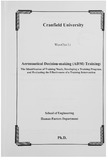JavaScript is disabled for your browser. Some features of this site may not work without it.
| dc.contributor.advisor | Harris, Don | |
| dc.contributor.author | Li, Wen-Chin | |
| dc.date.accessioned | 2009-12-07T19:45:34Z | |
| dc.date.available | 2009-12-07T19:45:34Z | |
| dc.date.issued | 2006 | |
| dc.identifier.uri | http://hdl.handle.net/1826/4054 | |
| dc.description.abstract | Flying a high-technology fighter with high stakes and under high g-force is not only an issue of skilled psychomotor performance but also of real-time decision-making involving situation awareness, choice amongst alternatives, time pressure and risk assessment. There is no aeronautical decision-making (ADM) training program for military pilots in existence neither in the R. O. C. Air Force nor around the world, although academic research had recognized the training needs for aeronautical decision-making. This research consists of three studies described in six chapters to develop an effective solution for ADM problems in order to improve military pilots' decision-making in a dynamic and time-limited tactical environment. The first chapter is an executive summary comprised by three studies. The second chapter identified ADM training needs by applied the Human Factors Analysis and Classification System (HFACS). Without good analysis it is impossible to identify precisely the training needs and the nature of the training content required for improving pilots' performance. The third chapter examined five ADM training mnemonics in six different decision-making scenarios for developing an ADM training program. There are many ADM mnemonics available. However, there was lack of empirical research investigating the efficiency of those ADM mnemonics in the real-time tactical environment. The fourth chapter evaluates the effectiveness of ADM training program by simulator trials and pencil and paper trials. The fifth chapter is overall discussion, followed by the final chapter containing conclusions and recommendations. This research demonstrated that ADM training program did improve pilots' in-flight decision-making performance. Improvements in pilots' situation assessment and risk management were obtained, but these were traded-off for response time. To improve the quality of pilots' decision-making, the ADM training program needs to be coordinated with real-time simulator scenarios training. The findings have demonstrated that the ADM training program significantly improved pilots' situation assessment and risk management. However, it still needs to be established if these performance gains continue to be evident at a later date during actual operations. | en_UK |
| dc.language.iso | en | en_UK |
| dc.publisher | Cranfield University | en_UK |
| dc.title | Aeronautical decision-making (ADM) training : the identification of training needs, developing a training program and evaluating the effectiveness of a training intervention | en_UK |
| dc.type | Thesis or dissertation | en_UK |
| dc.type.qualificationlevel | Doctoral | en_UK |
| dc.type.qualificationname | PhD | en_UK |
